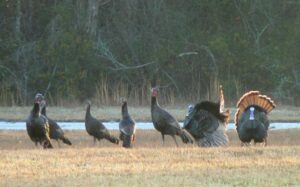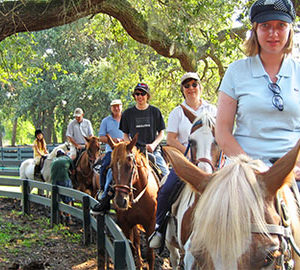You may see one in the median, while you drive down Hwy. 278.
You may see them in your backyard or on a golf course. Bluffton and the Lowcountry have many wild turkey living in and loving our area, just like we do! With Thanksgiving just around the corner, we thought we’d give you the low down on these down-producing birds.
The wild turkey (Meleagris gallopavo) is native to North America.
Adult wild turkeys have long reddish-yellow to grayish-green legs. The body feathers are generally blackish and dark, sometimes grey brown overall with a coppery sheen that becomes more complex in adult males. Adult males, called toms or gobblers, have a large, featherless, reddish head, red throat, and red wattles on the throat and neck. The head has fleshy growths called caruncles.
Male turkeys have a long, dark, fan-shaped tail and glossy bronze wings.
The male is substantially larger than the female, and his feathers have areas of red, purple, green, copper, bronze, and gold iridescence. The preen gland (uropygial gland) is also larger in male turkeys compared to female ones. Females, called hens, have feathers that are duller overall, in shades of brown and gray. The primary wing feathers have white bars. Turkeys have 5000 to 6000 feathers.

Vocalizations
Turkeys have many vocalizations: “gobbles”, “clucks”, “putts”, “purrs”, “yelps”, “cutts”, “whines”, “cackles”, and “kee-kees”. In early spring, males older than a year old (sometimes called gobblers or toms) and, occasionally to a lesser extent, males younger than a year old (sometimes called “jakes”) gobble to announce their presence to females and competing males. The gobble of a wild turkey can be heard up to a mile away. Males also emit a low-pitched “drumming” sound, produced by the movement of air in the air sac in the chest, similar to the booming of a prairie chicken. In addition they produce a sound known as the “spit” which is a sharp expulsion of air from this air sack. Females also gobble like males, but sparingly; they “yelp” to let males know their location. Both adult and immature males often yelp like females.
Social structure and mating
So, as you sit down to your holiday meal, you talk turkey with your new-found knowledge of this fowl.
Source: https://en.wikipedia.org/wiki/Wild_turkey.



